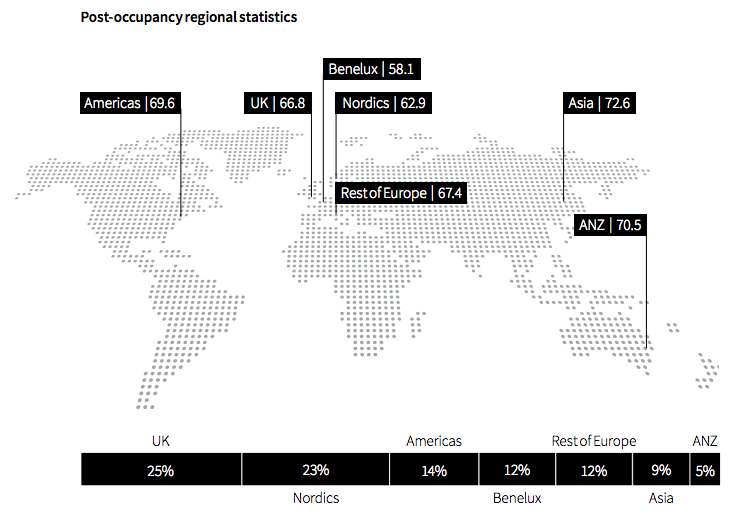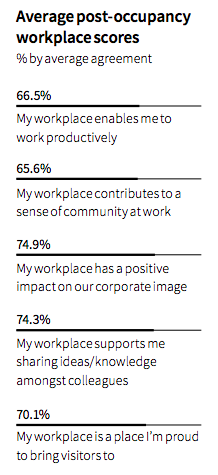One in five new workplaces fails to meet employee needs according to Leesman’s latest research.
In 2018 the team at Leesman introduced The Workplace Experience Revolution. Using data from 400,000+ global employees, Leesman examined how they experience their workplace. The research uncovered how opinions clustered into three distinct groups; Doing, Seeing and Feeling, and went on to reveal the workplace elements most influencing sentiment expression around these subjects as captured in our executive summary, ‘Unearthing the Real Drivers of Employee Sentiment’.

Now, Leesman is sharing ‘The Workplace Experience Revolution Part 2: Do new workplaces work?’ This report is the culmination of their nine-year analysis across 557,959 employee responses in 3,932 workplaces worldwide (data as of 30th June 2019). The first part of the study, published in 2018, unearthed a series of mission-critical ‘super drivers’ that provide the foundations for outstanding employee workplace experience. Part 2 takes this investigation a step further by exploring the challenges and stresses that organizations encounter when it comes to delivering employee experience in a new workplace.
The findings from the latest research are drawn from 346 spaces that have been measured by Leesman specifically in the post-occupancy phase after a workplace relocation or refurbishment. This group, which comprises 84,158 individual employee responses, provided Leesman with an opportunity to investigate where workplace change projects succeed or fail at a scale never before undertaken.
Leesman’s data challenges McKinsey & Company’s often-cited statistic that ‘70 percent of change management projects fail’. While 41 percent of new workplaces deliver an exceptional employee experience (with a Leesman Index effectiveness score (Lmi) of 70 or above), 40 percent have not maximized their full potential (scoring between 60-60.9), and 19 percent are failing their occupants (recording an Lmi below 60).
Specifically, three main findings stood out:
 Working productively
Working productively
‘The Workplace Experience Revolution Part 2’ reveals that 66.5 percent of respondents in new workplaces agree that their workplace enables them to work productively. Viewed in reverse, however, this means that one in three respondents cannot agree that their new workplace allows them to be productive.
Collaborative and concentrative working
Workplace change projects generally succeed in collaborative areas such as bringing people together and supporting interaction. For example, the vast majority of people in these spaces are satisfied with ‘planned meetings’ (87 percent), ‘informal social interaction’ (84.4 percent), and ‘accessibility to colleagues’ (72.3 percent).
New workplaces, however, notably fall short when it comes to supporting individual and concentrative tasks. Only 59 percent of employees in the new workplaces are satisfied with ‘private conversations’. Meanwhile, ‘noise levels’ delivers the most damning results, with just 33.4 percent of respondents satisfied in new workspaces.
Flexible or designated seating
The data suggests that neither flexible nor designated workspace will guarantee a successful change project. It’s all about providing employees with the right environment for the right activities. Employees with less complex roles, for example, report less improvement following workplace change projects compared to their peers with more complex roles.
Leesman’s report highlights that a growing number of organizations understand the variation in their employees’ work tasks and are building more variety into their workplaces as a result. The data suggests, however, that organizations risk incorporating more variety at the detriment of those who primarily do individual desk-based work.
Tim Oldman, Leesman CEO, added: “The data unveiled in part two of our Workplace Experience Revolution report should concern business leaders. The results are indicative of a workplace industry that is all too ready to jump on the latest industry trends without a proper understanding of what their employees do and need in their workplaces.
“A workplace change project provides organizations with an opportunity to reimagine their employees’ experience at work in a way that can ignite individual and organizational performance. But success hinges on supporting what employees are doing and how they are doing it. If leadership teams fail to recognize the needs of their people, they risk delivering workplace changes that hinder rather than help employee experience.”
Interested in learning more? Click to download the full report ‘The Workplace Experience Revolution Part 2: Do new workplaces work’ report in full.
About Leesman
Leesman is the world’s leading measure of employee workplace experience. Founded in 2010 by CEO Tim Oldman, Leesman provides quarterly insights into the world of workplace and business intelligence via the Leesman Review, based on a global reach database of over 4,000 workplaces across 90 countries and more than 500,000 respondents internationally. In addition to this, Leesman regularly publishes research reports on key topics and areas of focus led by Development Director & Head of Insights and Research, Dr. Peggie Rothe.
Leesman measures employee experience via the Leesman Index – a global business intelligence tool that captures employee feedback on how effectively the workplace supports them and their work. The consequent findings provide organizations with critical insight into how a building is performing. Performance is then benchmarked against the world’s largest statistically robust employee experience database.
For more information, please contact Sabrina Stubbs on [email protected] or on +44 (0) 7743 056320..

